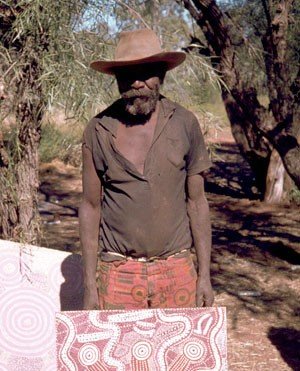CHARLIE TJARURU TJUNGURRAYI
MARKET ANALYSIS

Photo: Graeme Marshall
As is the case with so many of the artists who worked directly with Geoffrey Bardon, Charlie Tjaruru’s top selling works were produced during the 1971-1972 period including 9 of his top 10 results. His record is held by brilliant, striking and memorable black and white image with a unique story, titled The Trial 1972. This 40.5 x 76 cm. board more than doubled its presale high estimate of $100,000 when it sold for a startling $212,000 at Sotheby’s in July 2004. The superiority of this image over the rest of his 1972 paintings is attested by the fact that only 11 of the 15 works offered at auction have sold, and those that have been successful of which only 2 have achieved prices in excess of $30,000. Only 10 of his 1971 paintings have been offered at auction and only 7 of these sold. Those works which have failed, or have achieved prices under $10,000 were either rather stark images, or the application of dotted in-fill created an unfortunate spotty effect, thereby marring the iconic imagery. It was a small 20.5 x 60 cm. 1971 board with unusual and striking image, and an evocative story, that achieved theartist’s top price. Fear 1971 sold for $87,500 at Sotheby’s in July 2001 and this remains the artist’s second highest record to date.
In the mid 1980’s Charlie Tjaruru travelled, with Papunya Tula art adviser Andrew Crocker, through the USA, Europe and England and met Queen Elizabeth II. This was the inspiration for the only 1980’s work in his highest results. An Audience with the Queen created in 1989 and measuring 121 x 121 cm. sold for $70,250, more than double its high estimate, in Sotheby’s July 2001 auction still the artist’s third highest result and the only work in his top ten results that was not produced between 1971 and 1972.
Very few of his works from the 1980’s have been presented or accepted for auction and the majority have sold for less than $2,000. The exceptions were three quite large canvases between which took around $7,000 on average. This is due to the lack of interest in repetitive Tingari site paintings lacking in energy and harmonic tension. With 90works having been offered at auction it is somewhat surprising that so few have been re-presented. Two that first appeared during the 1997 and 1998 period dropped in value slightly when offered again in 2000 and 2003, while a 1975 Tingari painting increased in value slightly from the $3120 sale price at Sotheby’s in July 2003 to $3,840 when offered in June 2005 at Lawson-Menzies.
Despite his renown and high prices paid for a small number of his works Charlie Tjaruru’s paintings have not performed well at auction. Apart from his early boards and a small number of thematic paintings produced during the 1980’s there are many formulaic paintings only distinguishable from a large group of generic paintings produced by Pintupi male artists post 1975. Today there are so many wonderful Aboriginal artists and art styles from such a diversity of regions that it would be better to avoid one of Charlie Tjaruru Tjungarrayi’s paintings after 1973 unless it is especially aesthetically pleasing.
© Adrian Newstead

